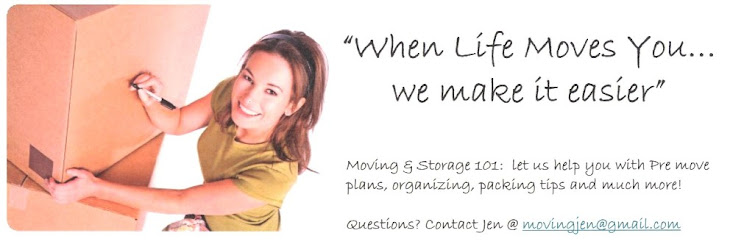
"There Is No Such Thing As Too Many Labels" by C. Ewer, An Organized Home
Establish Move Central, and Make It Portable
Moving has more tentacles than an octopus. Between wooing The Amazing Disappearing Handyman at the old house and penetrating the layers of voice mail protecting The High-Tech Realtor at the new, you're making more calls than an old-time switchboard operator. It's easy to lose your mind along with your train of thought --- not to mention all those little business cards that will Enter Move Central.
Even if you never use a planner at home or on the job, a business planner or moving notebook is more important to a move than boxes and tape. Find one at the local office supply store. Get one with big pages, one for each day, and throw in some business card holders, zipper pouches and receipt envelopes.
How will you use it? Let me count the ways. During the crazy pre-move house-hunting days, you'll track phone calls, make notes on houses you've toured, and gather phone numbers for the gazillion new close friends you'll make --- all those realtors and rental agents and mortgage people and moving-van guys and handymen you'll come to know and loathe quite intimately in the coming weeks. Tuck all business cards into their own little slots for easy reference. Make notes of the seventeen consecutive days you've spent trying to track down the Tile Man (after he's gotten your money but before you've seen Tile One go up on the kitchen wall).
Cram snippets of flooring and wallpaper, paint swatches and drapery goods into a see-through zipper pouch for at-the-store decorating reference. Dedicate one receipt envelope for those fix-up-the-old-place receipts. Another receipt envelope holds receipts generated by house-hunting trips and travel to your new home. Stuff everything in there, and you'll thank yourself at tax time!
After the move, you'll use Move Central to schedule appointments to turn on your lights, water, cable and other essentials of life. If a neighborhood mom mentions a good pediatrician, note the name and you're ahead of the game! Tuck a local map into a flap or pocket, and you'll always be able to get yourself where you're going --- even if you don't always get there very directly.
Treat Move Central as just another body part --- it should be with you always. Handles and outside pockets let it replace your purse. Yes, you'll develop a permanent list to one side from the weight, but like that caused by a hip-hugging toddler, it's temporary. Having all your information in one place right at hand is key to a smooth and sane move.
"There Is No Such Thing As Too Many Labels"
"Real" organizational experts, those paragons with the alphabetized spices, often espouse complicated moving "systems" involving inventories, color-coded marker pens, and lots of lists. My hand aches just to think about it!
Here in at Organized Home, we practice guerilla home management: translation, "reality". We all know what happens to all those good, color-coded intentions: 243 boxes marked "misc." in illegible hand with a nearly-dry marker pen. Then in the new house, you get to play "hunt the bed sheets" and a good time will not be had by anyone.
For computer users, there's a simple solution. One that will ensure that all your boxes make it to the room where they belong with minimal effort. One that eliminates writer's cramp and all those "where's the marker?" fights with other family members.
Labels. Computer-generated labels. Hundreds of them. Repeat after me: "There is no such thing as too many labels."
You will go to the office supply store. You will purchase a large box of the cheapest computer labels available for your computer printer. If you have an old tractor-feed printer in the kids' room somewhere, it's perfect for this task.
Open any word processor. Do what you have to do to tell it to make labels --- they're pretty easy to instruct these days. Then make several hundred --- yes, I said, several hundred --- labels for your boxes, a hundred or so for each room or area in your house:
•Kitchen
•Living room
•Family room
•Master bedroom
•Girl bedroom
•Boy bedroom
•Bathroom
•Storage
Load that printer up and let it chug out your labels while you go try and find Tile Man one more time. You'll end up with stacks and stacks of labels. Next step: get 'em on the boxes.
This one's easy. Give each packer, whether you pay somebody else or assign the chore to your not-at-all-cheerful family, a stack of labels for whatever room s/he is packing. As each box is packed, just slap a label in the upper-left-hand corner of every side of the box.
Yes, I said "upper-left-hand corner". Trust me. It's where the names are written in nursery school. That's the place everyone looks first --- so that's where the label goes. And yes, I said "on every side of the box". That means four labels per box, one per side.
This is not overkill. At the new house, you will thank yourself. No straining the back flipping the box to find the side with the label. No hoisting six different boxes to find the designation printed so neatly on the top of the box. One glance and anybody can figure out where that baby goes.
How? Because you're going to take some sheets of paper and label every room: "Master Bedroom", "Kitchen", "Family Room." Tape a nice little sign above the door to every room. Paid movers, volunteer helpers or unwilling teens, they'll all know what goes where with a single glance.
Finally, decide where you want your storage boxes to live until you can sort them out. Tape a "Storage" sign high up on that wall, whether it's garage or extra bedroom or the long wall in your master bedroom.
Get things close to where they belong, and you've won half the unpacking battle!
Pack the Essentials Last
The concept of the "Survival Box" is one dear to the hearts of all moving advisers and organizational experts. You know what that is, right? It's a box containing the essentials of life: coffeemaker and children's nighttime loveys, bed sheets and blankets and pillows, an alarm clock. Paint it red, plaster it with Little Mermaid stickers, do something to it so it stands out like a sore thumb, and put it in the truck last, so it's first out in the new house.
Your Survival Box should contain all those items you'll need for the first day and night in your new home. With small children, think about including dishes, cereal and the paraphernalia of a family breakfast. The CEO has honed her essentials of life down to a very individual list: traveling coffeemaker and supplies, portable computer, and Perry, her teddy bear. Your Survival Box will reflect your own family's needs.
Don't stop there! Think bigger than a single box. Those same small children can be entertained quite handily if you pack the boxes containing television, VCR and Barney tapes at the back end of the truck! Will you need cleaning tools and a vacuum? A tool box to assemble furniture and hang art? Think about your immediate needs, and hold those essentials back until the bitter end.
First shall be last and last shall be first, so to speak.
Keep Your Sense of Adventure
Let's be honest. For a wife and mother, there's more riding on any move than her own well-being. Husbands, bless 'em, tend to see the process in terms of dollars and moving companies and estimates and utility deposits.
For women, a move is infinitely more complex. Have we found a neighborhood that will meet our children's needs? How do we cope with a teen's anger at being uprooted, while coaxing him toward acceptance of and openness to his new community? It's not just a roof we seek, but church and school, doctors and vets, parks and playgrounds --- all the tiny, glowing facets of the quilt of our family's life must be weighed, considered, and replaced, and the job, my friends, is ours.
But have you ever considered the possibilities of a move? For all but the most ruthlessly self-disciplined among us, a move is the only chance we have to pull back, reexamine our lives, and try on a new identity!
Source: www.anorganizedhome.com














